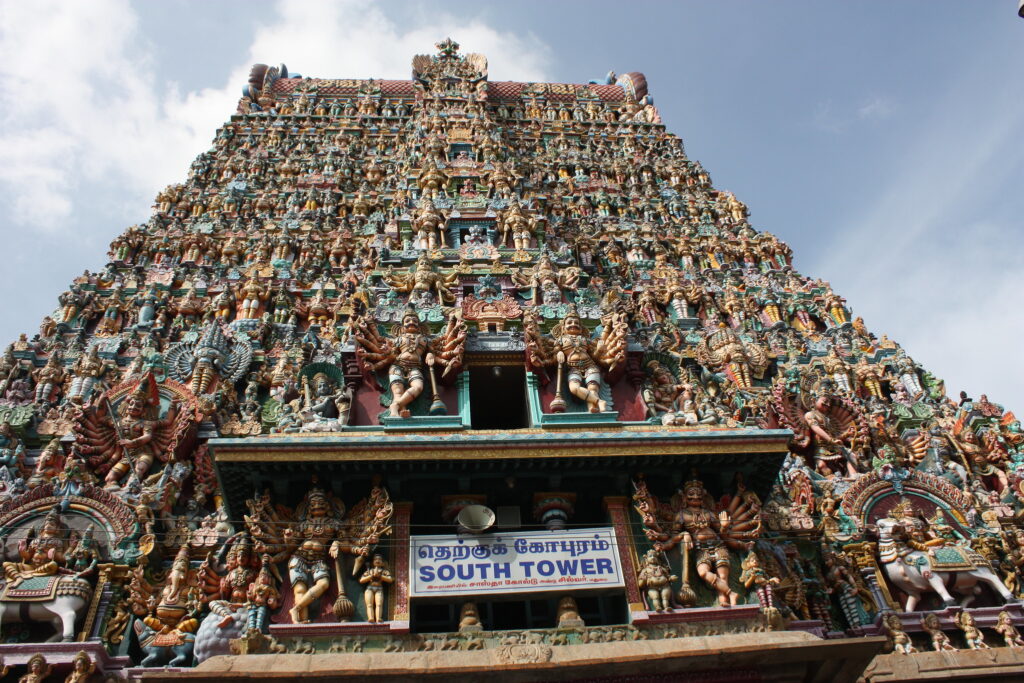Madurai, Tamil Nadu, is home to the Meenakshi temple, one of the most pristine Hindu temples in India. The temple is a treasury of myths and miracles, many of which are still unknown to us. Let’s explore the interesting history of this splendid temple.

The Story of Meenakshi Amman
The Meenakshi Amman temple is dedicated to the couple, Goddess Parvati and Lord Shiva. Meenakshi was born out of a sacred fire and had three breasts. Right after her birth, a heavenly voice assured her parents, a Pandyan king, and his wife, that the third breast of their daughter will disappear the day she will meet her husband.
Meenakshi grew up to be a great warrior and took over the throne after her father. The ambitious queen went on to conquer multiple adjoining kingdoms. Soon she set out to take possession of the Kailash and met Lord Shiva. At that moment, her third breast fell off, indicating that she had met her husband. The couple came back to Madurai for their wedding ceremony. The wedding was presided over by Lord Vishnu following which the couple ruled the Madurai kingdom, and are still believed to watch over the city and its devotees.
Temple Structure
The foundation of the temple is believed to have been laid in the 7th century C.E. However, the temple we see today was built in the 16th and 17th centuries. The temple is situated in the centre of Madurai and is spread over 56,700 square meters of land. The entire construction is a well-planned one, and a bird’s eye view depicts a mandala.
The Gopurams (Gateways)
Fourteen massive gopurams surround the entire temple and lead to the shrines. Out of these gateways, five are considered to be the most important. The Nadukattu, Sundareswarar Shrine, Mottai, Chitra, and Kadaka Gopurams are considered as the primary ones.
These gateways have a multi-level structure, where each level is adorned with picturesque carvings that describe narratives from the mythology. The southernmost gopuram is the tallest of all, having a height of 170 feet.
The Shrines
Multiple shrines together compose the entire complex of the Meenakshi Amman temple. The two primary shrines in the centre are dedicated to Goddess Meenakshi and Lord Sundareswarar. The remaining are for other Hindu Gods and Goddesses. The shrines are where the ceremonies are performed.
The Potramarai Kulam
This is the pond located right in the middle of the temple and considered sacred by the devotees. What makes this water body so special? Well, it is the pond with a golden lotus, which is the direct translation of its name. The pond features a golden lotus in the centre and has no marine life by the benediction of Lord Shiva.
The Mandapams
Mandapams are halls standing on firm pillars, dedicated to many deities. The main purpose was to provide a relaxing place for the pilgrims. Ashta Shakthi, Swamy Sannidhi, Nayaka, Kilikoondu are some major mandapams in the temple arena.
Significance of Meenakshi Temple
The temple is a tribute to the power of a woman and represents the importance of the women in a family. It is a ritual to offer the prayers to Meenakshi before worshipping Sundareswarar. It is also believed that Lord Shiva performed a cosmic dance in the halls of the Sundareswarar shrine. It is in this temple that Shaktism, Vaishnavism and Shaivism form a union.
Every year numerous festivals are celebrated in this 2500 years old temple. The Golu festival is a ten-day-long festival, celebrated during the Navratri. Golus or small idols are made that portray the characters of mythological stories. Meenakshi Thirukalyanam is another major festival that rejoices the union of gods and goddesses.

Pingback: Top 10 Famous Temples to Visit in India - Auchitya
Pingback: Madurai's Chithirai Thiruvizha Festival - Auchitya